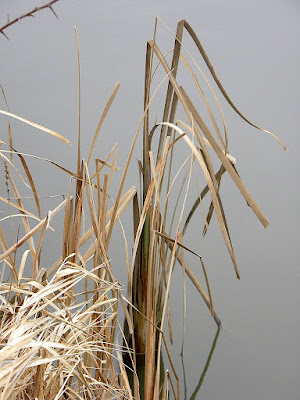Monday turns out to be a very good day to visit Reifel Island. After the rush of weekend visitors, there is a lull; even the clamorous mallard horde has left the begging grounds and gone about its business on the ponds and islets. We walk surrounded by birdsong, the tweets and trills and whistles that we rarely hear over the demands of the ducks. "What's that one?" we say. We don't know, and I promise myself, once again, to review the tape of bird calls "as soon as ..."; well, soon, at least.
It's spring; the business in hand is home and family. Some, like yesterday's geese, are well along with the first brood, but most are still sitting on nests, out of sight. The sandhill cranes have two eggs on an island towards the centre of the sanctuary; a notice at the gate warns us to be cautious passing their nest.
We were walking down one of the central trails, under a canopy of branches. On either side, canals separated us from bird territory, mostly brush. Overhead, suddenly there was a great hubbub of honks and calls; geese rose from the bush and wheeled away in pairs, shouting as they went. Silence again. We walked on.
A bit later, from the other side, down in the bush, something else, something big and noisy, raised a ruckus. This was a voice I'd never heard before; louder than a goose, more raucous than a great blue heron, a rattling, grating, machine-like noise; loose nuts and bolts in a washing machine drum, maybe. Angry nuts and bolts.
I tried to imitate it later, for a woman from the sanctuary office. I'm pretty good with quacks and caws, but this was beyond me; she couldn't identify the noisemaker. I think it was probably a sandhill crane, objecting to our visit, too close to those cherished eggs.
*Update: I just registered with Dendroica; I found there several recordings of the sandhill's voice. That was it; check #5 or #7, for example. "A loud, trumpeting rattle," is their description.
From an observation deck on the next leg of the trail, we looked down on a pair of Canada geese in the water. The female was interested in my bag of seeds, but the male had more important things on his mind. He followed the female about, stretching his neck out parallel to the water's surface, eyes on her, pleading. His voice was a deep growl, rather than a honk. She ignored him, no matter how intently he groaned and postured. After she looked over my offerings, she turned her back and swam away.
The abandoned male consoled himself with the seeds that, by now, had sunk to the bottom.
Silent protest.


















































